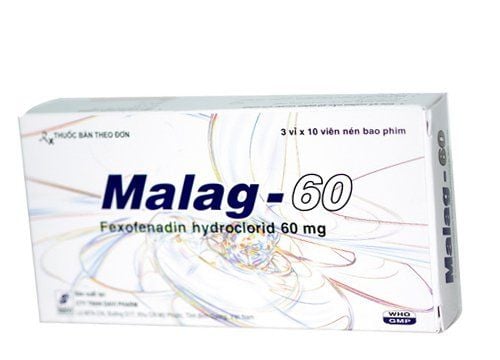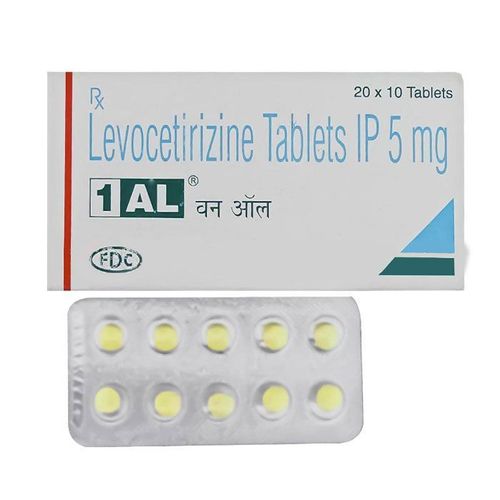This is an automatically translated article.
Inflex is mainly used to treat seasonal allergies or chronic idiopathic urticaria. Patients need to use Inflex medicine at the dose and frequency recommended by the doctor to minimize the risk of experiencing side effects.
1. What is Inflex?
Inflex drug belongs to the group of anti-allergic drugs, used for cases of hypersensitivity. Inflex is a product of Ind-Swift Ltd circulating in Vietnam, containing the main ingredient is Fexofenadine hydrochloride and other excipients just enough. The drug is prepared in the form of film-coated tablets, including 2 types: Inflex 120mg or Inflex 180mg, packed in boxes of 10 blisters x 10 tablets.
2. Indications and uses of Inflex 2.1. Indications for the use of Inflex drug As recommended by the doctor, Inflex medicine is usually indicated for use in the following cases:
Treatment of symptoms caused by seasonal allergic rhinitis. Treatment of chronic idiopathic urticaria. Helps minimize allergy symptoms such as runny nose, sneezing, watery eyes, itchy nose or red itchy eyes. 2.2. Uses of the drug Inflex *Pharmacodynamics of the drug Inflex
The main active ingredient in Inflex is Fexofenadine hydrochloride - belonging to the 2nd generation antihistamine group, which acts as a peripheral H1 receptor antagonist. Fexofenadine is a long-acting active ingredient that helps treat allergic conditions, but does not have the ability to induce sleep. Fexofenadine is a metabolite of terfenadine, which inhibits bronchoconstriction and inhibits histamine production from peritoneal mast cells. Animal studies have shown that this active substance does not have the ability to inhibit a 1-adrenergic or anticholinergic receptors. In addition, the study also did not find Fexofenadine to have a sedative effect on the central nervous system. The drug has a rapid and prolonged action due to its slow binding mechanism to the H1 receptor, thereby forming a stable complex and dissociating relatively slowly.
*Pharmacokinetics of Inflex drug
Active ingredient Fexofenadine is rapidly absorbed after oral administration, peak plasma concentrations average about 2.6 hours. Following oral administration of Fexofenadine at a dose of 60 mg, the peak plasma concentration of the active substance was 142 ng/ml. When Fexofenadine 60mg twice daily is taken orally, the peak blood concentration of the drug will be at equilibrium, approximately 286ng/ml after only about 1.42 hours. However, when Inflex is taken with food, Fexofenadine can be reduced by about 17%, but has no effect on the time to peak concentration.
According to research, the pharmacokinetics of the active ingredient Fexofenadine is linear when administered at a dose of 120mg x 2 times / day. Of these, about 70% of Fexofenadine is bound to plasma proteins, mainly a alpha - 1 - glycoprotein and albumin.
The volume of distribution of Fexofenadine ranges from 5.4 – 5.8 liters/kg. The drug was not detected in the placenta or in breast milk, however, Fexofenadine was found to be a metabolite of Terfenadine in breast milk. In addition, the active substance Fexofenadine does not cross the blood barrier.
It is estimated that about 5% of the total dose of Inflex is metabolized in the body, of which about 0.5 - 1.5% of Fexofenadine is metabolized in the liver to inactive substances via the cytochrome P450 enzyme system and approx. 3.5% converted to methyl ester derivatives by intestinal bacteria. The elimination half-life of the active ingredient Fexofenadine in Inflex is about 14.4 hours, in patients with renal impairment it will be longer. The drug is eliminated mainly in the feces (about 80%) and 11-12% of the dose is excreted in the urine as unchanged drug.
3. Dosage and instructions for using Inflex
3.1. Dosage of Inflex drug Inflex drug is recommended for use in children 12 years of age and older and adults with seasonal allergic rhinitis or chronic idiopathic urticaria, specifically:
Dosage for treatment of allergic rhinitis Seasonal response: Take 60mg x 2 times / day, the doctor can also prescribe the patient to take 120mg or 180mg / time / day. Dosage for chronic idiopathic urticaria: Oral 60mg x 2 times / day or dose 180mg / time / day. For patients with allergic renal failure: Oral starting dose of 60mg/time/day or as directed by the physician. 3.2. Instructions for using Inflex correctly Each drug or drug will be prepared in many different forms, so the way to use it is not the same. Common ways of using drugs to treat diseases will include: Injections, oral drugs, suppositories or topical applications. For Inflex, patients need to take the drug orally because the dosage form of the drug is tablets. When taking the medicine, you should drink the same amount of filtered water, do not take the medicine with meals or with other drinks such as milk, soft drinks, carbonated water,...
Before and during hypersensitivity treatment With Inflex medicine, patients need to carefully read the instructions for use written on the enclosed prescription or take it as directed by the doctor. Patients absolutely do not arbitrarily use Inflex in other ways without the approval of the doctor.
3.3. Management of Overdosage or Missing of Inflex *For Inflex Overdosage
Although there have been no cases of acute overdose associated with the use of more than the recommended dose of Fexofenadine, however, patients with an overdose of Fexofenadine medication may experience noticeable symptoms such as dry mouth, dizziness and drowsiness. To handle an overdose of Inflex, the doctor will remove the active ingredient that has not been absorbed in the gastrointestinal tract. In certain cases, hemodialysis can reduce the concentration of fexofenadine in the blood, but not significantly (only about 1.7%). In addition, there is currently no specific antidote for Inflex overdose.
*For the case of forgetting to take a dose of Inflex
When forgetting to take a dose of Inflex, the patient should try to take the medicine as soon as possible. In case you remember the missed dose too close to your next dose of Inflex, you should skip the old dose and continue taking the new dose according to the prescribed schedule. Absolutely do not arbitrarily make up twice the prescribed dose because this can easily lead to the risk of experiencing symptoms of Fexofenadine overdose.
4. Some side effects of Inflex drug During the treatment of allergies with Inflex medicine, patients may experience some adverse effects (ADRs). According to the results of clinical studies, side effects in patients receiving Fexofenadine occurred similar to those receiving Placebo. On the other hand, side effects caused by Inflex were not affected by the age, dose, sex or race of the patient.
Common side effects of Inflex, including:
Neurological symptoms such as fatigue, drowsiness, insomnia, headache or dizziness. Gastrointestinal symptoms such as indigestion or nausea, vomiting. Other symptoms include dysmenorrhea, cold/flu virus infection, upper respiratory tract infection, cough, fever, itchy throat, sinusitis, otitis media or back pain. Uncommon side effects of Inflex include:
Sleep disturbances. Fear. Or have nightmares. Stomachache. Dry mouth . Rare side effects of Inflex, including:
Severe allergic reactions such as itching, hives or rash. Hypersensitivity reactions such as chest tightness, angioedema, flushing, dyspnea or anaphylaxis. In general, the side effects of Inflex are usually mild and not too serious if encountered. According to the study, only about 2.2% of patients had side effects that forced them to stop treatment with Inflex.
4. Important notes during treatment with Inflex
4.1. Contraindications to the use of Inflex Inflex should be avoided in the following cases:
Children under 12 years old (due to difficulty in assigning the correct dose). People with a history of allergy to the active ingredient Fexofenadine or other active ingredients in the drug. Patients with renal failure should not be treated with Inflex 180mg. 4.2. Precautions when taking Inflex The following are things that patients need to be cautious about during hypersensitivity treatment with Inflex, including:
Although the drug does not cause the same cardiotoxicity as terfenadine, it is not If you are at risk of heart disease or have a long QT interval before, you should still carefully monitor your health when using Inflex. Do not use any additional antihistamines during the treatment of allergies or chronic idiopathic urticaria with Inflex. Patients over 65 years old, with liver failure also need to be very careful when using Inflex because there are not enough studies or data on safety when using the drug in these subjects. For children under 6 years of age, there are no specific data on the effectiveness and safety of Inflex, therefore, it is not recommended to use the drug in children of this age when there are no indications. Discontinue Inflex at least 24-48 hours before the patient undergoes intradermal antigen tests. 4.3. Using Inflex drug for pregnant women and nursing mothers *Note taking Inflex drug during pregnancy
The use of Inflex during pregnancy can lead to some dangerous effects for any stage of pregnancy , especially in the first trimester, can easily cause complications such as teratogenicity, miscarriage, and fetal malformations. Therefore, it is best not to use Inflex medicine for pregnant women. If it is necessary, the patient should discuss carefully with the doctor before deciding on treatment.
*Note to use Inflex during lactation
Inflex medicine can be passed on to babies while breastfeeding, so it should be limited or avoided during breastfeeding. Mothers should carefully consult a doctor or read the instructions for use before treating allergies with Inflex.
4.4. Interactions of Inflex with other drugs When co-administering Inflex with Ketoconazole or Erythromycin can increase the plasma concentration of Fexofenadine by 2-3 times. If you are taking magnesium hydroxide or aluminum-containing antacids, patients need to take these drugs at least 2 hours before taking Inflex, because taking too close to the time or at the same time can affect the ability to absorption of Inflex in the gastrointestinal tract.
In summary, Inflex is mainly used to treat seasonal allergies or chronic idiopathic urticaria. During the use of the drug, if you experience any unwanted side effects, the patient should consult the prescribing doctor.
Please dial HOTLINE for more information or register for an appointment HERE. Download MyVinmec app to make appointments faster and to manage your bookings easily.













